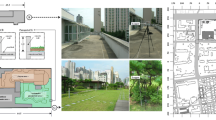Abstract
Green roofs have the potential to retain stormwater on the roof surface and lower the thermal loading on buildings. Because of this, the greatest environmental benefits from green roofs might be achieved in subtropical climates characterized by high temperatures and intense rain events. There is, however, little research to support this. In a replicated study in Texas, we compared the performance of six different extensive green roof designs vegetated with native species, to non-reflective (black) roofs, and reflective (white) roofs. Preliminary hydrologic and thermal profile data indicated not only differences between green and non-vegetated roofs, but also among green roof designs. Maximum green roof temperatures were cooler than conventional roofs by 38°C at the roof membrane and 18°C inside air temperature, with little variation among green roofs. Maximum run-off retention was 88% and 44% for medium and large rain events but some green roof types showed very limited retention characteristics. These data demonstrate indicate that: 1. Green roofs can greatly affect the roof temperature profile—cooling surface layers and internal space on warm days. 2. Green roofs can retain significant amounts of rainfall, this is dependent on the size of the rain event and design and can fail if not designed correctly. We suggest that as green roofs vary so much in their design and performance, they must be designed according to specific goals rather than relying on assumed intrinsic attributes.



Similar content being viewed by others
References
Bengtsson L, Villarreal EL (2005) Response of a Sedum green-roof to individual rain events. Ecol Eng 25:1–7 doi:10.1016/j.ecoleng.2004.11.008
Dunnett N, Nagase A, Booth R, Grime P (2005) Vegetation composition and structure significantly influence green roof performance. In: 3rd North American Green Roof Conference: greening rooftops for sustainable communities. The Cardinal Group, Washington, DC
Getter KL, Rowe DB (2006) The role of extensive green roofs in sustainable development. HortScience 41:1276–1285
Hintze JL (2001) Number Cruncher Statistical System. NCSS, Kaysville, Utah
Kohler M, Schmidt M, Grimme FH, Laar M, Paiva VLA, Tavares S (2002) Green roofs in temperate climates and in the hot–humid tropics—far beyond the aesthetics. Environ Manag Health 13(4):382–391 doi:10.1108/09566160210439297
Larcher W (1995) Physiological plant ecology, 3rd edn. Springer, Berlin
Liu K, Minor J (2005) Performance evaluation of an extensive green roof. In: Greening rooftops for sustainable communities. Washington, DC, pp 1–11
MacMillan G (2004) York University rooftop garden stormwater quantity and quality performance monitoring report. In: Greening rooftops for sustainable communities, Portland OR
Niachou A, Papakonstantinou K, Santamouris M, Tsangrassoulis A, Mihalakakou G (2001) Analysis of the green roof thermal properties and investigation of its energy performance. Energy Build 33:719–729 doi:10.1016/S0378-7788(01)00062-7
Palomo E, Barrio D (1998) Analysis of the green roofs cooling potential in buildings. Energy Build 27:179–193 doi:10.1016/S0378-7788(97)00029-7
Rowe DB, Rugh CL, VanWoert N, Monterusso MA, Russell DK (2003) Green roof slope, substrate depth, and vegetation influence runoff. In: Proceedings of the 1st North American Green Roof Conference: greening rooftops for sustainable communities. The Cardinal Group, Chicago, pp 354–362
Rowe DB, Monterusso MA, Rugh CL (2006) Assessment of heat-expanded slate and fertility requirements in green roof substrates. Horttechnology 16:471–477
Seters TV, Rocha L, MacMillan G (2007) Evaluation of the runoff quantity and quality performance of an extensive green roof in Toronto Canada. In: Fifth Annual Greening Rooftops for Sustainable Communities Conference, Minneapolis, MN
Teemusk A, Mander Ü (2007) Rainwater runoff quantity and quality performance from a greenroof: the effects of short-term events. Ecol Eng 30:271–277 doi:10.1016/j.ecoleng.2007.01.009
Theodosiou TG (2003) Summer period analysis of the performance of a planted roof as a passive cooling technique. Energy Build 35:909–907 doi:10.1016/S0378-7788(03)00023-9
VanWoert ND, Rowe DB, Andresen JA, Rugh CL, Fernandez RT, Xiao L (2005) Green roof stormwater retention: effects of roof surface, slope, and media depth. J Environ Qual 34:1034–1044 doi:10.2134/jeq2004.0364
Velasco PCT, Srebric J, Berghage R (2007) Thermal performance of a lightweight tray for the green roof growing media. In: Fifth Annual Greening Rooftops for Sustainable Communities Conference, Minneapolis, MN
Wong NH, Chena Y, Ong CL, Siab A (2003) Investigation of thermal benefits of rooftop garden in the tropical environment. Build Environ 38:261–270 doi:10.1016/S0360-1323(02)00066-5
Acknowledgments
The authors wish to thank City of Austin, Watershed Protection and Development Review Department, Austin Energy, RCI (Institute of Roofing, Waterproofing, and Building Envelope Professionals) Foundation, and TBG Partners for sponsoring this project. We also wish to thank Ken Ollinger RRC, CCCA who constructed the steel test assembly structures, roofing contractors who provided material and thousands of hours in labor, including: Dean Contracting, D. R. Kidd Roofing, Empire Roofing, Fifth Wall Roofing, L. S. Decker, Port Enterprises and Texas Roofing.
Author information
Authors and Affiliations
Corresponding author
Rights and permissions
About this article
Cite this article
Simmons, M.T., Gardiner, B., Windhager, S. et al. Green roofs are not created equal: the hydrologic and thermal performance of six different extensive green roofs and reflective and non-reflective roofs in a sub-tropical climate. Urban Ecosyst 11, 339–348 (2008). https://doi.org/10.1007/s11252-008-0069-4
Published:
Issue Date:
DOI: https://doi.org/10.1007/s11252-008-0069-4



